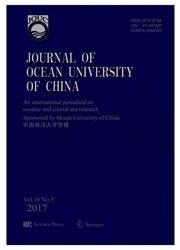

 中文摘要:
中文摘要:
Zygosaccharomyces rouxii is a salt-tolerant yeast species capable of removing cadmium(Cd) pollutant from aqueous solution. Presently, the physiological characteristics of Z. rouxii under the stress of sodium chloride(NaCl) and Cd are poorly understood. This study investigated the effects of NaCl and Cd on the growth, oxidative stress and antioxidant enzyme activities of Z. rouxii after stress treatment for 24 h. Results showed that NaCl or Cd alone negatively affected the growth of Z. rouxii, but the growth-inhibiting effect of Cd on Z. rouxii was reduced in the presence of NaCl. Flow cytometry assay showed that under Cd stress, NaCl significantly reduced the production of reactive oxygen species(ROS) and cell death of Z. rouxii compared with those in the absence of NaCl. The activities of superoxide dismutase(SOD), catalase(CAT), and peroxidase(POD) of Z. rouxii were significantly enhanced by 2%–6% NaCl, which likely contributed to the high salt tolerance of Z. rouxii. The POD activity was inhibited by 20 mg L-1Cd while the SOD and CAT activities were enhanced by 8 mg L-1 Cd and inhibited by 20 mg L-1 or 50 mg L-1 Cd. The inhibitory effect of high-level Cd on the antioxidant enzyme activities of Z. rouxii was counteracted by the combined use of NaCl, especially at 6%. This probably accounted for the decrease in Cd-induced ROS production and cell death of Z. rouxii after incubation with NaCl and Cd. Our work provided physiological clues as to the use of Z. rouxii as a biosorbent for Cd removal from seawater and liquid highly salty food.
 英文摘要:
英文摘要:
Zygosaccharomyces rouxii is a salt-tolerant yeast species capable of removing cadmium (Cd) pollutant from aqueous solution. Presently, the physiological characteristics of Z. rouxii under the stress of sodium chloride (NaCl) and Cd are poorly under-stood. This study investigated the effects of NaCl and Cd on the growth, oxidative stress and antioxidant enzyme activities of Z. rouxii after stress treatment for 24 h. Results showed that NaCl or Cd alone negatively affected the growth of Z. rouxii, but the growth-inhibiting effect of Cd on Z. rouxii was reduced in the presence of NaCl. Flow cytometry assay showed that under Cd stress, NaCl significantly reduced the production of reactive oxygen species (ROS) and cell death of Z. rouxii compared with those in the absence of NaCl. The activities of superoxide dismutase (SOD), catalase (CAT), and peroxidase (POD) of Z. rouxii were significantly enhanced by 2%-6%NaCl, which likely contributed to the high salt tolerance of Z. rouxii. The POD activity was inhibited by 20 mg L-1 Cd while the SOD and CAT activities were enhanced by 8 mg L-1 Cd and inhibited by 20 mg L-1 or 50 mg L-1 Cd. The inhibitory ef-fect of high-level Cd on the antioxidant enzyme activities of Z. rouxii was counteracted by the combined use of NaCl, especially at 6%. This probably accounted for the decrease in Cd-induced ROS production and cell death of Z. rouxii after incubation with NaCl and Cd. Our work provided physiological clues as to the use of Z. rouxii as a biosorbent for Cd removal from seawater and liquid highly salty food.
 同期刊论文项目
同期刊论文项目
 同项目期刊论文
同项目期刊论文
 Effect of inorganic salts on the growth and Cd2+ bioaccumulation of Zygosaccharomyces rouxii culture
Effect of inorganic salts on the growth and Cd2+ bioaccumulation of Zygosaccharomyces rouxii culture Effect of sodium chloride and cadmium on the growth, oxidative stress and antioxidant enzyme activit
Effect of sodium chloride and cadmium on the growth, oxidative stress and antioxidant enzyme activit Halomonas shantousis sp nov., a novel biogenic amines degrading bacterium isolated from Chinese ferm
Halomonas shantousis sp nov., a novel biogenic amines degrading bacterium isolated from Chinese ferm Effect of NaCl on the heavy metal tolerance and bioaccumulation of Zygosaccharomyces rouxii and Sacc
Effect of NaCl on the heavy metal tolerance and bioaccumulation of Zygosaccharomyces rouxii and Sacc As(III) removal from aqueous solution using alpha-Fe2O3 impregnated chitosan beads with As(III) as i
As(III) removal from aqueous solution using alpha-Fe2O3 impregnated chitosan beads with As(III) as i Effects of dietary chitosan oligosaccharide complex with rare earth on growth performance and innate
Effects of dietary chitosan oligosaccharide complex with rare earth on growth performance and innate 期刊信息
期刊信息
